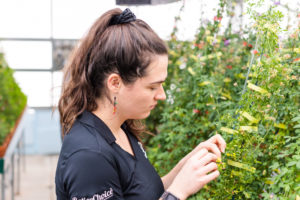Greenhouse Pollinations
By Olivia Steinmetz | February 16, 2022
Along with our pathology work – as laid out in the previous article “Winter in the Greenhouse” – another big task we do in the fall and winter are pollinations.
 Much like how we mimic nature in our disease screens, when we pollinate plants in the greenhouse we are imitating what happens naturally, but in a controlled setting. In nature (and in our big seed production fields out in Idaho) alfalfa is pollinated by bees who land on flowers, get coved in pollen, fly away to another flower, and transfer the pollen. We do this with a small piece of folded cardstock paper, transferring pollen from plant to plant to plant.
Much like how we mimic nature in our disease screens, when we pollinate plants in the greenhouse we are imitating what happens naturally, but in a controlled setting. In nature (and in our big seed production fields out in Idaho) alfalfa is pollinated by bees who land on flowers, get coved in pollen, fly away to another flower, and transfer the pollen. We do this with a small piece of folded cardstock paper, transferring pollen from plant to plant to plant.
Alfalfa is an open-pollinated, outcrossing tetraploid. Let’s break down what that means… Tetraploid means that an alfalfa plant has four copies of each chromosome whereas we are a diploid species and get one copy of each chromosome from each of our two parents. This means that alfalfa has a lot of genetic material, and multiple copies of every gene we’re looking for! Outcrossing is like the opposite of selfing; alfalfa has high levels of self-incompatibility, so it is best to pollinate each plant with pollen from a different plant, instead of pollinating each plant with its own pollen like a soybean. Each alfalfa plant that is being pollinated can give pollen to other plants (father) and receive pollen from other plants (mother), and each alfalfa variety has many parents. This is why we say that alfalfa varieties are more like families or populations, and why a field of alfalfa is so much more genetically diverse than a field of hybrid corn.
 The plants that we are pollinating in the greenhouse were brought in from our field nurseries. We work with a few different populations at a time and each population has between 30 and 100 individual plant parents. This gives us enough seed to work with in the pathology greenhouse and get an extra generation in, but we would never be able to produce enough seed to sell this way. Sure, the flowers are fragrant and beautiful – but after hand pollinating for a few weeks, we are thankful for the bees that do all the hard work out west!
The plants that we are pollinating in the greenhouse were brought in from our field nurseries. We work with a few different populations at a time and each population has between 30 and 100 individual plant parents. This gives us enough seed to work with in the pathology greenhouse and get an extra generation in, but we would never be able to produce enough seed to sell this way. Sure, the flowers are fragrant and beautiful – but after hand pollinating for a few weeks, we are thankful for the bees that do all the hard work out west!

